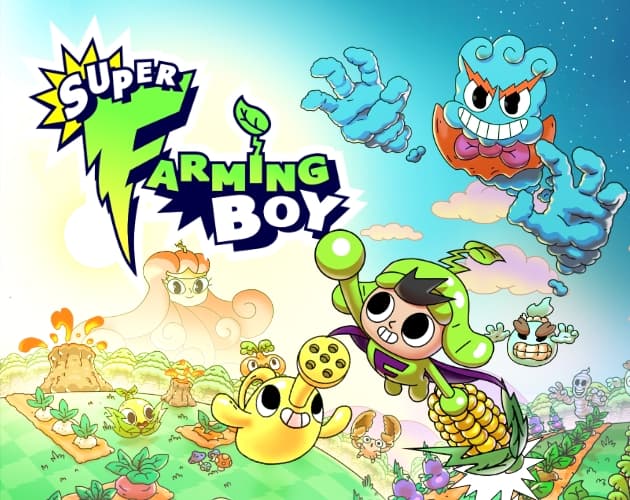
I went into Super Farming Boy expecting a cozy Harvest Moon throwback I could half-play with a podcast on. What I got was a surprisingly crunchy, combo-driven farming puzzler that made me redraw my plots at 1 a.m., mumbling “one more day” like a gremlin. And then, just when I’d dialed in a beautiful chain-harvest, the game would make me misplant a row by a single tile, burn half my stamina trying to fix it, and I’d swear out loud at my television. It’s that kind of game: intoxicating when its systems align, irksome when the port’s touch-first roots show their seams.
For context: I played about 19 hours on the Steam version across two setups-PC (Ryzen 5 5600, RTX 3060, Xbox Series controller) and Steam Deck OLED. I mostly stuck with a controller because the game itself recommends it, but I did a short stint with mouse via Steam Input to see if precision felt better. My farm reached the late-Summer season with most of the core powers re-bought, and I triggered the game’s “crazy harvest” mode enough times to feel like a weekend produce tycoon.
The intro is playful: a mysterious cloud-suited capitalist floats in, strips your kid farmer of his powers, and yoinks your mom too. There’s a whiff of anti-corporate satire, but it evaporates almost immediately. After that, the game is refreshingly blunt-earn money, buy back powers, expand what you can, sleep, repeat. No town to schmooze, no romances to chase, no festival calendar. If you’re here for Stardew’s heart-to-hearts, this one doesn’t try to compete. It’s a laser-focused harvest machine with just enough flavor to frame the loop.
By the end of my first session (about 3 hours), I was firmly in “plan-and-execute” mode. That clarity is the game’s superpower: every day is about plotting optimal harvest chains that turn a few button presses into a chorus line of produce popping into your bag. Where most farm sims are about breadth, Super Farming Boy doubles down on depth-and puts the puzzle front and center.
Here’s the twist that turns “another farm sim” into something sticky. Each crop doesn’t just grow; it fires off an effect when you harvest it, hitting specific adjacent tiles. Plant the right pattern, harvest the right starting tile, and you’ll trigger a chain reaction that hoovers up your whole field with minimal input. The early standout is corn, which punches the tile to its immediate right when pulled. Ten corn planted in a straight eastbound line? One press, boom—gone, bag full.
And that’s just the tutorial-level stuff. As you unlock more seeds, the harvest patterns get stranger and way more interesting—L-shapes, diagonals, “two-tiles-over” strikes, even plants that scatter extra seeds when uprooted. I had an “aha” around hour 6 when I stopped thinking in rows and started sketching weird Z-shaped corridors and diagonal lanes. My favorite pattern was a spine of indirect hitters feeding into a finishing row of corn—a kind of conveyor belt that let me steer the chain across the field and then sweep the leftovers with one satisfying pull.
Performing long chains charges a special meter (mine sat in the top-right), and when it’s full you can trigger a short, glorious window where harvested crops regrow almost instantly. It’s like turbo mode for farmers. My best run happened on Day 11 of Summer: I built a daisy chain that cleared half the field, popped the meter, then sprinted back and forth hitting the same corn corridor while it kept refilling. The coin tally at midnight looked ridiculous—easily three days’ worth in one focused burst. The mechanic rewards planning and improvisation, in a way that felt more puzzle game than life sim, and I loved it.
Super Farming Boy runs on a four-season year, like most of its peers, but the tone shifts more than I expected. Spring is vanilla, almost a gentle tutorial for combo logic. Summer gets spicier with crop patterns that prefer diagonals, which forced me to rethink my grid. Autumn and Winter surprised me with field and environmental changes that weren’t just visual—there are small layout quirks and obstacle placements that push you into new shapes. The first time I woke up to a different look for my plot, I spent half a day just sketching a new plan with my hoe and seeds, trying to route a chain through the clutter.
Each season lasts 15 in-game days. On paper, that’s snappy. In practice, it adds a sense of urgency I found energizing but occasionally frustrating. Mid-Summer, I bought into a crop that needed a few days longer than I had; I miscounted by two, watched it wither at the season change, and just stared at the screen. Lesson learned: the scheduler in your head needs to be as optimized as your field layout. When the game clicks, that shortened calendar makes success feel earned. When you mistime a growth cycle, it’s a facepalm.

Money fuels everything. You’ll spend your hard-won coins to repurchase the abilities that cloud-boss stole, plus basic upgrades and consumables that help you muscle through the early-game stamina blues. There’s no relationship web or town economy to manage—it’s an unapologetically transactional treadmill that suits the game’s focused ethos. I didn’t miss the fluff most days; when the combo puzzle had me in a trance, an empty social calendar felt like a feature, not a bug.
That said, the lack of side arcs means you feel the grind more when it hits. On days when the field spawns a few too many obstacles, or the meter won’t quite fill, the loop can tilt from “clever optimization” to “work.” Which brings me to the most persistent frustration I had.
Super Farming Boy was built for touch, and even though the controller mapping is sensible, the single “context” button is a double-edged sword. On my Xbox pad, the same input waters, harvests, and picks up items depending on where you’re standing. It’s convenient until it isn’t. Early on, I repeatedly watered when I meant to pick up, or harvested when I was trying to line up a placement. Each mistake drains stamina, and boy does that bar evaporate fast in the opening seasons. Yes, you can buy stamina tonics at a fair price, and yes, upgrades help, but the first few hours are rougher than they need to be simply because of costly misinputs.
Planting precision is the real heartache. The grid is clear enough, but nudging a row into perfect alignment with a stick never felt trustworthy. Misplace a tile, and you can’t dig a mature plant back up to re-home it; your combo plan just… dies a little. After the fifth time I offset a line by one and bricked a long chain, I put the controller down, launched on my desktop, and tried a mouse-focused setup. It helped a touch—hover placement reduced oopsies—but the game’s UI and prompts are still built around that single-button flow. On Steam Deck, the control stick feels fine for movement but heightens the “oops I pressed it” problem. The best solution I found: walk slower and tap more deliberately, which is not exactly thrilling advice.
Then there are the rocks and logs. Clearing debris is Farm Sim 101, but here large rocks can take north of 20 hammer swings, and they spawn in ways you don’t control. I had one pop right through the midpoint of an L-shaped corridor I’d spent a few days nurturing. There’s a certain grim satisfaction in grinding it down, but the time cost feels out of whack with how essential clean geometry is to the harvest puzzle. If obstacles are going to be that beefy, I’d love a middle-ground tool upgrade or a way to pay to move, not destroy, them.
This one’s a looker in a cozy way. The field has just enough animation—plants shiver, particles pop on harvest—that your combos feel tactile. Seasonal swaps redraw the vibe rather than recolor it, which kept me eager to wake up and peek out the door. The soundtrack leans jaunty; there’s a whistlable theme that lodged in my head for a whole day. It’s not a massive production, but it’s cohesive, and that counts.
Performance-wise, I saw consistent micro-stutters at the start of some mornings, particularly after loading into a new day with lots of plants ready. On my desktop, the game otherwise ran buttery at high frame rates, but I’d get a hitch or two as the sun came up and systems spun up. On Steam Deck, I hovered around 60fps for most of a day, dipping to the mid-40s the instant a big chain kicked off with heavy particle effects. None of it broke the loop, but it was noticeable enough that I started hitting my harvest meter after the heavy stutter had already happened, just to avoid a mid-chain hitch. It feels like a game that will benefit from ongoing optimization as the PC version matures.
– After about 10 hours, I discovered a silly but effective trick: lay a row of seed-scattering plants perpendicular to a diagonal-hitting crop. Harvest the diagonal first to “prime” the scatter line, then pull the scatter row to reseed along the same diagonal. It was like bootstrapping my own assembly line, and I grinned like I’d broken the game.

– The first time I triggered the instant-regrow window at the exact second a long chain ended, I genuinely laughed. It’s that “free dessert” feeling you want from good score-chasing design, and it’s strong enough to carry the game through some of its rough edges.
– Conversely, I had a day where I lost a third of my stamina to back-to-back misinputs while trying to thread a placement between a weed and a rock. That was when I set the controller down and took a breather. The game works best when it lets your brain be the limiter, not your thumb precision.
If you love the “how can I squeeze 10% more output from this little rectangle” itch in games like Factorio’s early layouts or the placement puzzle of Islanders, this leans in your direction more than, say, the vibe-forward life sim crowd. It’s Harvest Moon by way of a chain-reaction puzzler. Your reward is the moment a day’s worth of thoughtful planting turns into a three-second harvest that feels like hitting a jackpot.
If what you crave is social sim texture—friendships, festivals, a town to explore—Super Farming Boy simply doesn’t aim there. And if stamina bars make you see red, the early game will test your patience. I’d still recommend it to cozy fans who don’t mind a sharper mechanical edge, but set expectations: this is more about patterns than people.
I don’t often include a wishlist in reviews, but this game sits so close to great that a handful of tweaks could elevate it:
After nearly twenty hours, I’m still pulling up plot tiles in my head, chasing the perfect cascade. Super Farming Boy is a sharper, more mechanical take on the genre that earns its place beside the usual suspects by daring to be about execution, not routine. When it sings, it really sings—your thumb taps once, the field detonates into motion, and the coin count at midnight makes you feel like you broke the economy.
But I can’t ignore the physical friction. The single-button context actions and touch-first precision can turn a good plan into a clumsy day, and early stamina drain exaggerates the sting. Add in some over-tanky rocks and a short season cycle that occasionally punishes ambition, and you’ve got a great core loop nudging against some port-era compromises.
Would I recommend it? Yes—especially if you like optimizing patterns and can stomach a few early fumbles. It’s a different flavor of farm sim, and I’m glad it exists. Just go in prepared to fight your thumbs as much as the weeds.
Rating: 7.5/10
Get access to exclusive strategies, hidden tips, and pro-level insights that we don't share publicly.
Ultimate Reviews Strategy Guide + Weekly Pro Tips